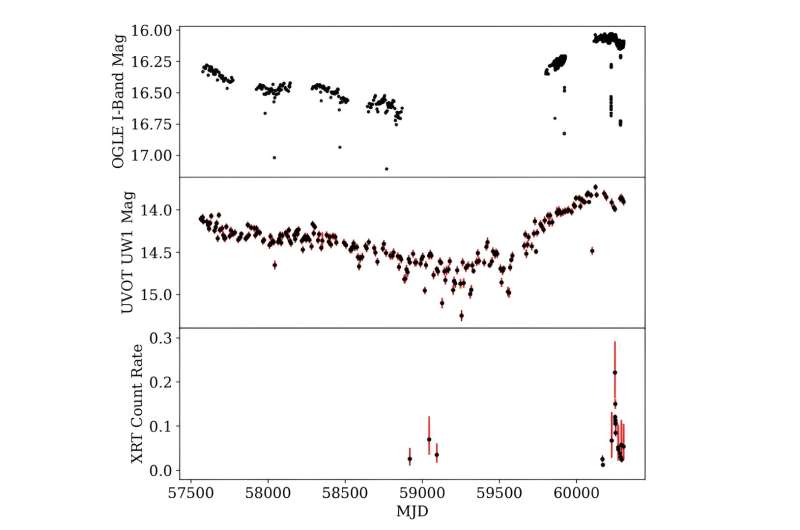March 20, 2024 report
This article has been reviewed according to Science X's editorial process and policies. Editors have highlighted the following attributes while ensuring the content's credibility:
fact-checked
preprint
trusted source
proofread
Astronomers discover a rare eclipsing X-ray binary

An international team of astronomers reports the detection of a rare eclipsing Be/X-ray binary system as part of the Swift Small Magellanic Cloud (SMC) Survey (S-CUBED). The finding was detailed in a research paper published March 12 on the preprint server arXiv.
X-ray binaries are composed of a normal star or a white dwarf transferring mass onto a compact neutron star or a black hole. Based on the mass of the companion star, astronomers divide them into low-mass X-ray binaries (LMXBs) and high-mass X-ray binaries (HMXBs).
Be/X-ray binaries (BeXRBs) are the largest subgroup of HMXBs. These systems consist of Be stars and, usually, neutron stars, including pulsars. Observations have found that most of these systems showcase weak persistent X-ray emission that is interrupted by outbursts lasting several weeks.
Now, a group of astronomers led by Thomas M. Gaudin of the Pennsylvania State University (PSU) has identified a new BeXRB, which received designation Swift J010902.6-723710, during S-CUBED monitoring observations aimed mainly at detecting X-ray outbursts.
"This paper reports the detection of a previously unknown BeXRB via weekly observations of the SCUBED survey. This new system, Swift J010902.6-723710, was identified via a transient X-ray outburst and followed up via multi-wavelength observations," the researchers wrote.
Swift J010902.6-723710 started an X-ray outburst on October 10, 2023, which showcased characteristics of Type I and II outbursts. Deep follow-up X-ray observations conducted by Gaudin's team identified a proposed spin period of 182 seconds for the neutron star in this system.
The astronomers have analyzed the light curve of both ultraviolet and infrared emission. As a result, they detected strong eclipse-like features that reappear every 60.623 days, which is adopted as the proposed orbital period of the system. This makes Swift J010902.6-723710 the third eclipsing BeXRB known to date.
Spectroscopic observations have revealed that the companion star in Swift J010902.6-723710 is a B0-0.5 star of spectral class Ve. Based on the spectroscopy, the researchers also identified a strongly double-peaked hydrogen-alpha emission line, which suggests that Swift J010902.6-723710 is a highly-inclined system with an inclination of 72–90 degrees.
Furthermore, the study confirmed the presence of a large accretion disk surrounding the neutron star in Swift J010902.6-723710, which was suggested by previous observations. The authors of the paper found that the detected eclipsing behavior is caused by this disk, which has a radius of approximately 3.3 solar radii.
Summing up the results, the researchers underlined the need for further monitoring of Swift J010902.6-723710 as it represents the rare class of eclipsing BeXRBs.
"We note that this rare behavior provides an important opportunity to constrain the physical parameters of a Be/X-ray binary with greater accuracy than is possible in non-eclipsing systems," the scientists concluded.
More information: Thomas M. Gaudin et al, Discovery of a Rare Eclipsing Be/X-ray Binary System, Swift J010902.6-723710 = SXP 182, arXiv (2024). DOI: 10.48550/arxiv.2403.05648
Journal information: arXiv
© 2024 Science X Network



















